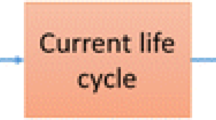Abstract
Goal, Scope and Background
In 2001, a new law on the recycling of end-of-life electric home appliances (EL-EHA) was put into effect in Japan; it was the first legislation of its sort in the world, and deserves to be called the ‘Japan model.’ This article is concerned with the LCA of alternative life-cycle strategies for EL-EHA, which consist of recycling as prescribed by the law, ‘ecodesign’ strategies such as the implementation of design for disassembly (DfD) and the extension of product life (EPL), with and without ex-post functional upgradability, and the once-dominant treatment methods such as landfilling and simple shredding.
Methods
We use the waste input-output (WIO) analysis, a new method of hybrid LCA that was developed by the authors [1]. The WIO extends the conventional input-output analysis to explicitly take into account the interdependence between the flow of goods and the flow of waste in the whole economy, and hence provides an optimal platform for LCA involving waste treatment and recycling. Furthermore, the WIO enables us to evaluate not only environmental impacts, but also economic impacts such as sectoral output and employment. Our analysis is based on the WIO table for 1995 and detailed process data on recycling.
Results and Discussion
Recycling was found to outperform the ‘traditional’ treatment method strategy with regard to the reduction of CO2 emission, landfill consumption, and the demand for abiotic resources. Thanks to efficient utilization of the existing retail network system, it was also found to be more efficient economically. Additional implementation of DfD and the associated increase in the quality of recovered materials (plastics) were found to augment the positive environmental impacts of recycling. The EPL without upgrading resulted in a significant reduction in the environmental impacts, but also in the level of employment. On the other hand, the EPL with upgrading was found to outperform the recycling strategy in terms of environmental impacts without having significant negative economic impacts.
Conclusion and Recommendation
Recycling of EL-EHA, as prescribed by the Japanese law on the recycling of EL-EHA, was found to be effective in reducing CO2emission, depletion of abiotic resources, generation of waste, and landfill consumption, provided the rate of retrieval remains at a high level. Our results also indicate the possible effectiveness of ecodesign strategy toward the realization of a sustainable economy.
Similar content being viewed by others
References
Nakamura S, Kondo Y (2002): Input-output analysis of waste management. Journal of Industrial Ecology 6, 39–64
Association for Electric Home Appliances (1999): Development of the Integrated Recycling System of Waste Electric Home Appliances: Progress Report 1998 (in Japanese with English summary)
Steinhilper R, Hieber M (2000): Manufacturing or remanufacturing? Decision management and success factors. Reichl H, Griese H (eds.) Electronics Goes Green 2000+, Proceedings, VDE Verlag, Berlin, 379–84
Umeda Y, Imagawa H, Shinomura Y, Yoshida M, Tomiyama T (2000): A proposal for design methodology for upgradability. Reichl H, Griese H (eds.) Electronics Goes Green 2000+, Proceedings, VDE Verlag, Berlin, 479–84
Umeda Y (1999): Key design elements for the inverse manufacturing, Proceedings of EcoDesign ‘99, IEEE Computer Society, Los Alamitos, 338–343
Matthews HS, Small MJ (2001): Extending the boundaries of life-cycle assessment through environmental economic input-output models. Journal of Industrial Ecology 4, 7–10
Rebitzer G, Loerincik Y, Jolliet O (2002): Input-output life cycle assessment: From theory to applications. Int J LCA 7, 174–176
Ministry of the Environment, Government of Japan (2002): On the current state of the enforcement of the recycling law, Press Release, 10 July 2002 (in Japanese) http://www.env.go.ip/press/Dress.php3Pserial=3464 (accessed September 2002)
Ministry of the Economy, Trade and Industry, Government of Japan (2004): The state of the export of end of life products and materials (in Japanese) http://www.meti.go.ip/report/downloadfiles/gll026g24i.pdf (accessed February 2004)
Kondo Y, Takase K, Nakamura S (2002): On the estimation of a waste input-output table for 1995. Nakamura S (ed.), Toward an Economics of Waste, Waseda University Press, Tokyo (in Japanese)
Nakamura S (2003): The waste input-output table for Japan 1995, version 2.2 http://www.f. waseda.jp/nakashin/research.html. January 2003 (accessed January 2003)
Hunkeler D, Rebitzer G (2003): Life cycle costing: Paving the road to sustainable development. Int J LCA 8, 109–110
Knoth R, Hoffmann R, Kopacek B, Kopacek P (2001): Intelligent disassembly of electr(on)ic equipment. Proceedings of EcoDesign 2001, IEEE, Los Alamitos, 557–561
Okada H, Ohnishi A, Iwata M, Gotoh T (2000): Environmentally conscious design for washing machines. The Fourth International Conference on EcoBalance, Proceedings, Tsukuba, Japan, 65–66
Tanaka S, Matsuto T (1998): Report on the Development of the Evaluation System that Supports the Integrated Control of Municipal Waste. Graduate School of Environmental Engineering, Hokkaido University (in Japanese)
Economic and Social Research Institute, Cabinet Office, Government of Japan (2004): Consumer Confidence Survey http://www.esri.cao.go.ip/en/stat/menu.html (accessed March 2004)
Management and Coordination Agency, Government of Japan (1999): 1995 Input-Output Tables. The Federation of National Statistics Associations, Tokyo
Yokota K, Matsuno Y, Yamashita M, Adachi Y (2003): Integration of life cycle assessment and population balance model for assessing environmental impacts of product population in a social scale case studies for the global warming potential of air conditioners in Japan. Int J LCA 8, 129–136
Sanou M, Fujita A, Kosan C, Yamada A, Fujisaki K (2000): Environmental assessment for treatment of used office appliances. The Fourth International Conference On EcoBalance, Proceedings, Tsukuba, Japan, 581–4
Guinée JB (ed.) (2002): Handbook on Life Cycle Assessment. Kluwer, Dordrecht
Yoshida T, Otsuka Y, Ueno K, Sunami A (2000): Life cycle assessment on recycling of electrical home appliances: Prediction and results through operation. The Fourth International Conference on EcoBalance, Proceedings, Tsukuba, Japan, 551–4
Author information
Authors and Affiliations
Corresponding author
Rights and permissions
About this article
Cite this article
Kondo, Y., Nakamura, S. Evaluating alternative life-cycle strategies for electrical appliances by the waste input-output model. Int J LCA 9, 236–246 (2004). https://doi.org/10.1007/BF02978599
Received:
Accepted:
Issue Date:
DOI: https://doi.org/10.1007/BF02978599




